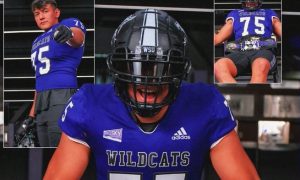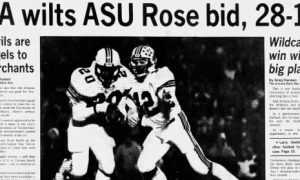[rps-paypal]

|
|
The Arizona football team begins its 2013 season against Northern Arizona at Arizona Stadium on Aug. 30, which is 60 days away. From now until then, this Web site will count down the days with facts about the Wildcats, their players, coaching staff and opponents. This is not a ranking, only a list of 100 facts and observances related to the 2013 Arizona football team and coach Rich Rodriguez.

The new FieldTurf and enclosed north end of Arizona Stadium make the 84-year-old stadium look like new (GigaPan.com picture).
Arizona’s football team officially has a new home today. Well, sort of.
Today is the target date for Arizona personnel to begin occupying the new Lowell-Stevens Football Facility at the north end of Arizona Stadium.
At 84 years old, Arizona Stadium was in need of a face-lift. Now it only needs a unique name and more respect.
Athlon ranked the stadiums in the Pac-12 recently and Arizona Stadium ranked No. 10, only ahead of Utah’s Rice-Eccles Stadium and Washington State’s Martin Stadium.
The publication based its rankings on “huge attendance numbers, home-field advantage in the win-loss column, rich traditions, picturesque landscapes and amenities”.
UCLA’s affiliation with the Rose Bowl is ranked too high at No. 3. As Athlon admits, “roughly 20,000 empty seats per game last year for a team that won the Pac-12 South championship.” That alone should move the stadium down the rankings.

Expansion on the north side of Arizona Stadium pictured last July (University of Arizona Planning, Design and Construction photo)
The mystique of the Rose Bowl is the game between the Pac-12 and Big Ten champions and the Bowl Championship Series title game this season. It really has nothing to do with the Bruins, which is a shame because of the talent UCLA has produced over the years.
Arizona fans have nobody to blame but themselves for the Wildcats’ low ranking. The Wildcats’ average attendance last year was an unbelievably low 47,931. The home schedule included Oklahoma State, USC, Washington, Oregon State and Arizona State.
The fans, mostly students who comprise the “Zona Zoo”, also left the stadium by halftime in many of the games.
The capacity was reduced 51,811 last season because of the $72.3 million expansion construction of the Lowell-Stevens Football Facility, a four-story building that houses locker rooms, football offices, a weight-training area and cafeteria, among other amenities.
The playing surface was also upgraded from natural grass to FieldTurf. The new turf will allow the team to practice on the field during the week when previously it was off limits while the grass recovered between games. The Revolution CoolPlay FieldTurf is designed to keep the surface temperatures cooler than with other artificial turf.

Arizona Stadium’s north end zone had a completion date of today, when this picture was taken (University of Arizona Planning, Design and Construction photo)
With the project completed heading into the 2013 season, the Arizona Stadium capacity will be increased to 57,800 and the enclosure of the facility should enhance a louder environment.
I remember when the east side of the stadium received a second tier, consisting of 17,000 seats, in 1976. That enhanced Arizona’s resume to enter what was then the Pac-8. Two years later, the Wildcats began playing in the Pac-10.
The Wildcats are not going anywhere this time after north-end zone and turf improvements, but they can make it to the big-time with an envious environment. Ranking No. 10 in the Pac-12 in anything is unacceptable.
ARIZONA STADIUM DEVELOPMENT
[table “” not found /]Javier Morales, WILDABOUTAZCATS.net, research. Data used from 2012 Arizona Football Media Guide.
The best No. 60 to wear the Arizona jersey, according to TucsonCitizen.com’s Anthony Gimino is offensive guard Rick Warren (1989-90), always be remembered for his fumblerooski runs in wins against Illinois and USC. The fumblerooski has since been outlawed by the NCAA.
WILDABOUTAZCATS.net publisher, writer and editor Javier Morales is a former Arizona Press Club award winner. He also writes blogs for Lindy’s College Sports, TucsonCitizen.com and Sports Illustrated-sponsored site ZonaZealots.com.
[rps-paypal]
|
|




























